Last Updated: November, 2023
We frequently see elaborate home theater systems featured in multi-million dollar mega mansions. But even if you live in more modest accomodations - and are working with a tight budget - you can bring home a taste of that movie theater experience. You don't have to settle for a puny flat screen TV and a flimsy sound bar. If you're a savvy shopper, you can put together a full-fledged home theater system, with a huge screen and powerful immersive surround sound system - even with Dolby Atmos - for under $2,000.
(If you're a #TL;DR kinda guy or gal then scroll all the way to the bottom for our recommendations of what to buy.)
Why Dolby Atmos, you might ask? If you've been to any premium movie screenings like Regal RPX or Dolby Cinema at AMC, you may have noticed sound coming from not only around you but above you as well. That's Dolby Atmos. It uses speakers all around the room and on the ceiling to create a more immersive surround sound experience, putting you in the middle of the action. Dolby Atmos has been encoded into hundreds of movies and even in TV series like "Game of Thrones," "House of the Dragon," "Westworld," "Altered Carbon" and "Squid Game." Dolby Atmos is even being used to encode music in immersive surround on streaming services including Tidal, Apple Music and Amazon Music. And now you can get that same cinematic immersive surround experience at home. Here's how to do it.
Note: We may earn a commission on purchases made through the links in this and other articles on this web site.
While the cost of flat panel TVs has dropped considerably over the years, it's still difficult to find a decent affordable flat panel TV with a screen size over 60 inches. And if you want to feel like you're at the movies, you're going to need to go bigger than that: a lot bigger. With a projector you can get a high quality 100-inch screen size (or even larger) at an affordable price. And I'm not talking about the super-cheap off-brand junk projectors you can only find online, but solid high performance projectors from well-established brands.
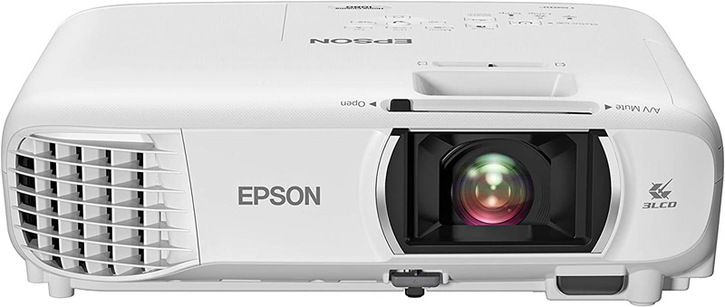
At the $750 price point, two projectors stand out: the Epson Home Cinema 1080 and the BenQ HT2050A. These are both Full HD 1080p projectors with excellent overall performance. The Epson uses 3 LCD chips to create the image while the BenQ uses single-chip DLP technology. The BenQ has the edge in black level reproduction and color accuracy, but the Epson is significantly brighter and won't suffer from the "rainbow effect" of a single chip DLP projector.
The BenQ does include a basic lens shift feature which simplifies installation a bit and it includes 3D support via optional active shutter 3D glasses. The Epson projector lacks 3D support or lens shift but does include automatic keystone controls to adjust the image geometry. If you're planning to install the projector in a living room or do a lot of viewing with the room lights on, the Epson may be the better choice. If you're seriously into movies, are planning to dim the lights most of the time or care about being able to view 3D content, then the BenQ may be preferred. The BenQ was also recently recommended by our friends Adrienne Maxwell at Wirecutter (best budget home theater projector) and Geoff Morrison at CNET (Editor's Choice). So it's got that going for it... which is nice.
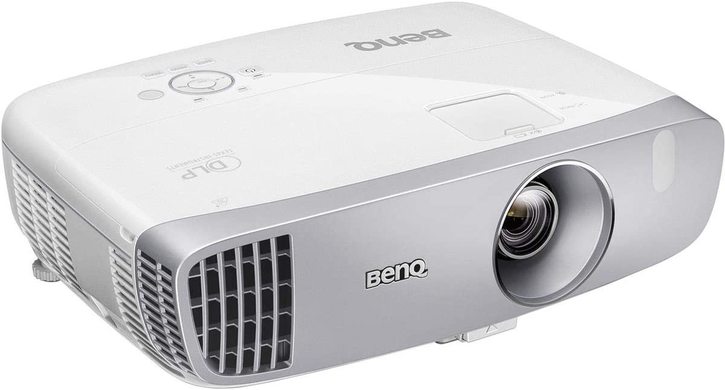
If you're itching to upgrade to 4K projection, the price is going to go up a bit. But you can still keep the projector cost under $900 with the ViewSonic PX701-4K. Like the BenQ HT2050A, the ViewSonic projector uses a single chip DLP device and color wheel, which means you might notice a rainbow effect when you turn your head. But this isn't that noticeable or annoying to many people. Also - just stop moving your head around so much, mmmkay?
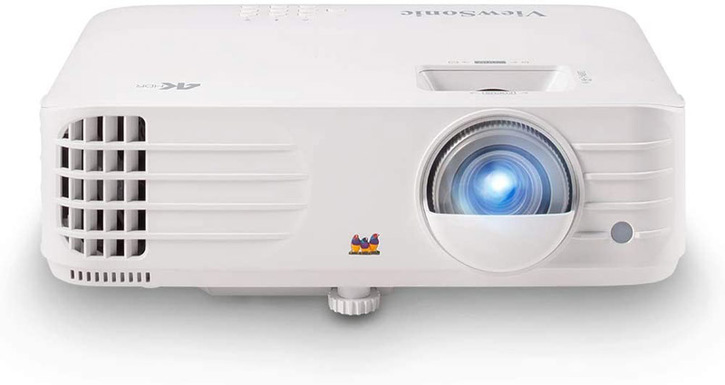
The PX701-4K is super bright (rated at 4,000 Lumens) and supports both HLG and HDR10 high dynamic range. It also has a low input lag at 4.2 microseconds in game mode, which makes it a great choice for gamers. Overall, the color accuracy and contrast pale a bit compared to the BenQ projector, but the extra detail will come in handy, particularly on larger size screens. The ViewSonic projector does not support 3D content so if you want 3D, then you're back to the BenQ.
While you can project your image on a wall with either projector, you'll get much better performance using an actual screen. The uniformity of the image is much improved, color accuracy is superior and the black border around the screen improves the perceived contrast. A good screen helps make the image "pop." At the entry-level price point, our pick for a screen is the Silver Ticket, which is available in a 100-inch size for about $229. It's a great screen that holds its own with screens costing two to three times more.
While there are some decent sound bars on the market today, and some of them even support Dolby Atmos (to an extent), most of the good ones are very expensive. And even the best ones can't match the flexibility or sound quality of a set of discrete home theater speakers driven by a good A/V receiver.
A high quality A/V receiver supports all of the latest immersive surround sound formats like Dolby Atmos and DTS:X. It also allows you to upgrade your system over time. My current pick for an entry level home theater receiver is the Denon AVR-S760H. The list price is $599, but you can find it online for about $500-$550, or even occasionally on sale for $450 at Costco, if you are a member. The AVR-S760H is a good-sounding receiver with plenty of inputs and features that make it a great centerpiece of a budget home theater system.
The AVR-S760H offers 75 Watts/Channel which can drive most speaker systems in small to medium sized rooms. It includes six HDMI inputs, with HDCP 2.3, 4K and 8K source and display compatibility. It supports both ARC (Audio Return Channel) and eARC (Enhanced Audio Return Channel), so you can connect it to your projector with just a single HDMI cable. It even includes a turntable input for all you vinyl lovers out there. Most importantly for immersive surround, the receiver includes seven built-in amplifiers so it can support true discrete 5.1.2-channel Dolby Atmos surround sound.
Update: We have noticed that stock for the Denon AVR-S760H varies. If you can't find it at a fair price, another option would be its big brother the Denon AVR-S960H. It offers everything the 760 has, but is more powerful at 90 Watts/Channel vs. the 760's 75 WPC and it offers an extra 8K-compatible HDMI port as well as more analog audio and video inputs. The 960 sells for $749 but you can find a factory-renewed one for about $499-$549 on Amazon:
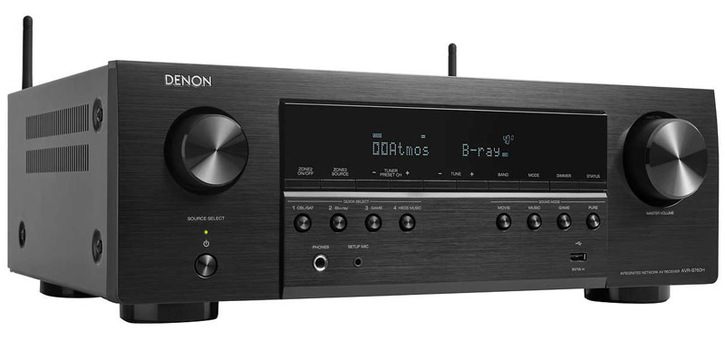
If you want to hit the ground running with full immersive surround sound, your simplest choice for speakers is a 5.1.2 channel bundle that provides all of the speakers you need for Dolby Atmos and DTS:X surround right out of the box. There are a few bundles that pack a nice sonic punch for not a lot of money. One solid entry-level choice is the 5.1.2 speaker bundle from Monoprice (also available on Amazon).
Monoprice established themselves in the electronics market by offering high quality accessories like HDMI cables, speaker cables and switches at bargain basement prices. They've been building up their brand with affordable home theater speakers and this particular system can keep up with more expensive systems from the bigger brands.
The Monoprice 5.1.2 system comes with four small satellite speakers, a center channel speaker and a powered subwoofer. The speakers' spring loaded terminals accept bare wire or pins (sorry - no banana plugs). The front left and right speakers include built-in upward-firing drivers so the height channel sounds from Dolby Atmos and DTS:X bounce off the ceiling to create sound from above.
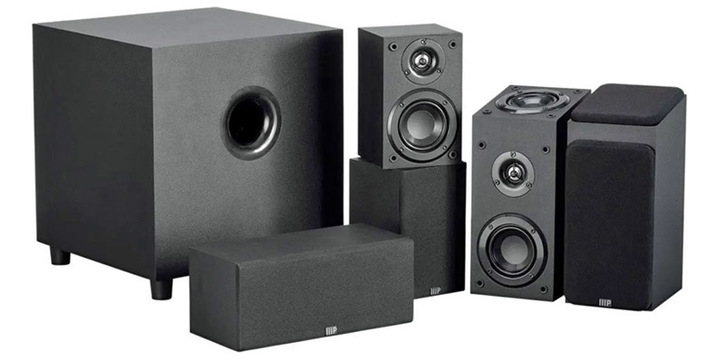
The ridiculous part is the price: the full Monoprice 5.1.2 bundle sells for $249 and even sometimes goes on sale at Monoprice.com for $199 or less. Combine this speaker bundle with the Denon receiver and you'll have a discrete 5.1.2 channel immersive surround sound system for somewhere between $650 and $800. That's less than the cost of a high end sound bar. Add in the projector and screen and you still come in at around $1,800 or less for the complete home theater system.
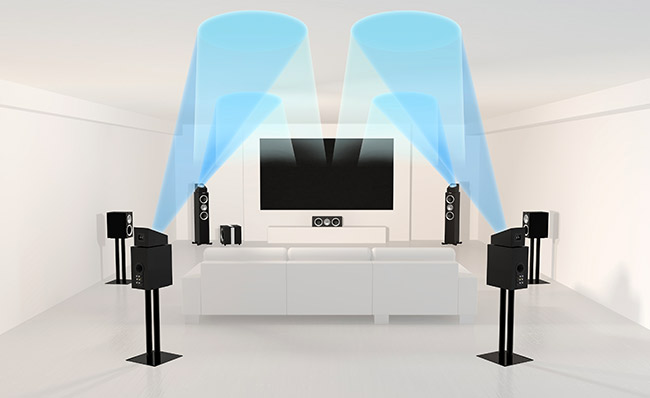
If you prefer to mount your height speakers on the ceiling for better height effects, but still want to keep the total system cost under $2,000, you can go with a 5.1 channel bundle like this one from Klipsch and then add a pair of Klipsch bookshelf speakers. The Klipsch B-200 bookshelf speakers are a bit larger than the satellite speakers in the 5.1 channel bundle (about 12" tall vs. 8" tall) but they are a great match both visually and sonically. All speakers feature a similar black finish and similar drivers for a cohesive surround soundstage. All-in pricing at current online discount prices for the 5.1 bundle and bookshelf speakers is around $440 which still keeps the system price with projector and screen under $2,000:
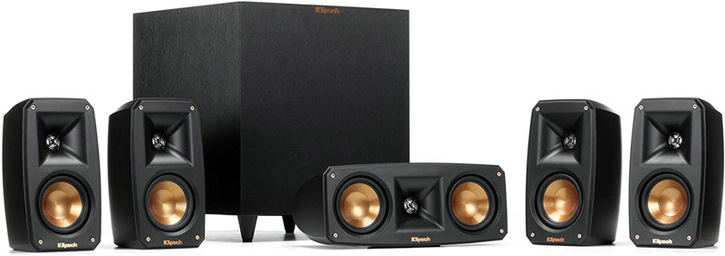
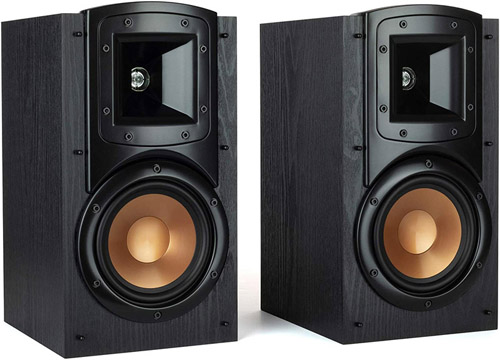
If you go this route, you'll get punchier, more dynamic sound as well as more realistic height effects. For this system, you would use the Klipsch Synergy Black Label B-200 Bookshelf Speakers as the main left and right speakers. Most sound from music and movies comes from the front three speakers, so it makes sense for these to be as good as they can be. Then you'd use two of the satellite speakers that come in the bundle as height speakers mounted high on the front wall, or on the ceiling, pointing toward the primary listening position. The remaining two speakers in the 5.1 pack go in the back of the room for your surround speakers. Any discrepancies in sound level among the seven speakers can be compensated for in the receiver's automatic speaker calibration.
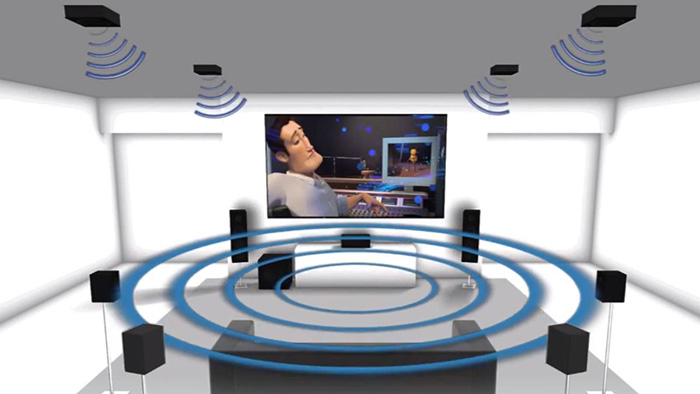
There are a few accessories that will come in handy to complete the system. I'll include links below. While you can mount either projector on a coffee table, it may be more convenient to get that projector out of the way by mounting it on the ceiling. This way you're less likely to accidentaly bump into it and have to readjust things. You'll want to get a projector mount that can place the projector at the right height from the ceiling and the correct distance from the screen. They're not super expensive. The last one I used for a similar installation was $20 on Amazon. It is a universal mount that should work with either of the recommended projectors.
You'll also probably need some cable: both of the speaker kind and the HDMI kind. Our recommendation would be to plug any source components (streaming stick or streaming box, cable box, etc.) into the receiver, then connect the receiver to the projector via one HDMI cable. Depending on the size of your room and where you mount the projector, you may need an HDMI cable that is 25 feet long or possibly longer. Use a tape measure to figure out how far it will need to be to get from the receiver to the projector, travelling in or on top of the wall and ceiling, then add about 5 feet for good measure (being a little too long is better than a little too short). A high quality 30-foot HDMI cable should be around $25-$30.
For speaker cable, you'll need to do a few more measurements. For the Monoprice speaker system, even though there are only five speaker boxes (plus the subwoofer), you'll need enough speaker wire for seven speakers. The front left and right speakers include two inputs: one for the main speaker and another for the height speaker at the top of the speaker cabinet. So basically just measure the distance from the receiver to the front left and right speakers, and double that, then add the distance for the center channel, then add the distance for the two rear speakers toward the back of your room.
If you go with the Klipsch system, you'll need cable for 5 speakers in the front: front left, center, front right, left height and right height, then two speakers at the back of the room. Add extra if you plan to hide the speaker wires in walls or in the ceiling. The Theater Pack 5.1 speakers's spring-loaded terminal accept bare wire or pins. The B-200 bookshelf speakers can accept bare wire, spade lugs or banana plugs.
Depending on the size of your room, 150-200 feet of speaker wire should be plenty to wire either system. We'd recommend speaker cable that's at least 16 gauge (AWG) or lower for best performance. 14 gauge cable is thicker (and better) but may be a bit thick for the spring-loaded speaker terminals.
The subwoofers of the two speaker options are a little different. The Monoprice subwoofer needs a cable with one RCA plug on one end and two RCA plugs on the other end. A basic dual-end RCA cable actually comes in the box, so you could use that in a pinch. The subwoofer in the Klipsch system is wireless so you won't need a cable for that. Ideal placement for either subwoofer is usually along the front wall (screen wall) but not too close to a wall or corner so the sound doesn't get boomy. A 15-foot subwoofer cable is probably sufficient (for the Monoprice system).
Unlike Smart TVs, most projectors (including the two recommended ones) do not include access to streaming apps - they're simply display devices. If you already have a Blu-ray player or streaming set top box like a Fire Stick or a Roku, then you can use these as sources for this system. If you need a source for streaming apps like Amazon Prime, Netflix, Hulu, etc., then we'd recommend the Amazon Fire Stick 4K or Roku Stick 4K. They both sell for around $50 (or less). Either one will work with these projectors and will continue to work in the future if you upgrade to a 4K projector.
The nice thing about a component-based home theater system is also the worst thing about a component system: upgradeability. Once you see how great a budget home theater system can look and sound, you may find yourself curious about how much better it could be with just a few little upgrades. You might decide to upgrade to a 4K-capable projector for even greater picture clarity. Or you may decide to upgrade to more powerful tower speakers or add in a second powered subwoofer for deeper bass response. The possibilities are endless on your path to cinematic perfection. You're welcome.
Projector (Pick One):
Receiver (Pick One):
Speakers (pick one):
Related Articles You May Also Like: